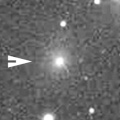
|
Now it is 8.3 mag (July 15, Michael Mattiazzo). It will fade out rapidly after this. In the Northern Hemisphere, it is not observable now, but it will be observable soon. In the Southern Hemisphere, it will be getting lower gradually after this, and it will be unobservable in October. But it will be observable again in July.
Date(TT) R.A. (2000) Decl. Delta r Elong. m1 Best Time(A, h)
July 15 22 8.76 -49 44.6 0.579 1.502 138 8.1 2:45 ( 0, 6)
July 22 19 18.34 -55 51.7 0.544 1.489 143 7.9 23:04 ( 0, -1)
|
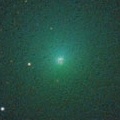
|
It brightened very rapidly. Now it is 8.8 mag (July 17, Carlos Labordena). It will fade out rapidly after this. It will be fainter than 18 mag in November. In the Northern Hemisphere, it stays observable in good condition. In the Southern Hemisphere, it is not observable now, but it will appear in August.
Date(TT) R.A. (2000) Decl. Delta r Elong. m1 Best Time(A, h)
July 15 18 9.84 79 43.9 0.555 1.052 77 9.2 22:44 (180, 45)
July 22 19 40.97 76 1.1 0.506 1.083 83 9.2 23:46 (180, 49)
|

|
Now it is 9.5 mag (July 15, Michael Mattiazzo). Fading slowly. In the Northern Hemisphere, it will be getting higher gradually. In the Southern Hemisphere, it stays observable in good condition.
Date(TT) R.A. (2000) Decl. Delta r Elong. m1 Best Time(A, h)
July 15 3 12.41 11 12.4 2.632 2.358 63 9.8 3:13 (273, 25)
July 22 3 12.51 8 57.1 2.520 2.386 70 9.8 3:20 (281, 31)
|
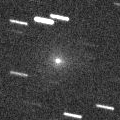
|
Now it is 12.7 mag (July 15, Michael Mattiazzo). It will fade out rapidly after this. It will be fainter than 18 mag in November. It stays extremely low. But it will become high in autumn in the Northern Hemisphere. It was expected to brighten up to 11 mag in July. But actually, it is fainter than this ephemeris recently.
Date(TT) R.A. (2000) Decl. Delta r Elong. m1 Best Time(A, h)
July 15 5 4.99 22 7.8 1.565 0.931 34 11.3 3:13 (249, 8)
July 22 5 39.29 21 16.1 1.601 0.940 33 11.3 3:20 (249, 8)
|

|
It brightened up to 8 mag from 2022 summer to 2023 spring. Now it is 11 mag (July 15, Michael Mattiazzo). It stays 12 mag for a while. In the Northern Hemisphere, it is not observable now, but it will appear in August. In the Southern Hemisphere, it will be getting higher gradually.
Date(TT) R.A. (2000) Decl. Delta r Elong. m1 Best Time(A, h)
July 15 6 13.48 -10 10.6 3.825 3.082 37 11.4 3:13 (265,-24)
July 22 6 19.62 -9 39.0 3.863 3.145 39 11.5 3:20 (269,-18)
|
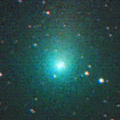
|
It brightened up to 9.5 mag from winter to early spring (Jan. 30, Katsumi Yoshimoto). Now it is 11.9 mag (July 15, Osamu Miyazaki). Fading gradually. In the Northern Hemisphere, it stays observable in good condition. In the Southern Hemisphere, it will be getting higher gradually.
Date(TT) R.A. (2000) Decl. Delta r Elong. m1 Best Time(A, h)
July 15 0 52.41 31 36.0 2.367 2.531 87 11.7 3:13 (267, 63)
July 22 0 46.97 30 15.3 2.297 2.592 95 11.8 3:20 (277, 70)
|
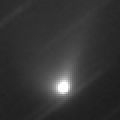
|
It brightened very rapidly as expected. Now it is 12.0 mag (July 15, Osamu Miyazaki). It will fade out rapidly after this. It stays observable in good condition.
Date(TT) R.A. (2000) Decl. Delta r Elong. m1 Best Time(A, h)
July 15 19 45.04 0 6.8 1.068 2.047 158 12.4 0:17 ( 0, 55)
July 22 19 40.17 0 36.0 1.082 2.060 158 12.5 23:40 ( 0, 56)
|

|
Now it is 13.7 mag (July 14, Chris Wyatt). It stays 13 mag for a while. In the Northern Hemisphere, it is not observable now, but it will appear in October. In the Southern Hemisphere, it will be unobservable in August. But it will be observable again in September.
Date(TT) R.A. (2000) Decl. Delta r Elong. m1 Best Time(A, h)
July 15 10 21.36 -9 0.9 4.305 3.751 51 12.6 20:57 ( 83, -7)
July 22 10 22.53 -9 50.6 4.405 3.767 45 12.6 20:51 ( 86,-11)
|

|
Now it is 13.8 mag (July 14, Chris Wyatt). Fading slowly. In the Northern Hemisphere, it is not observable now. It was expected to brighten up to 10 mag from spring to summer. However, it is fainter than originally expected.
Date(TT) R.A. (2000) Decl. Delta r Elong. m1 Best Time(A, h)
July 15 11 28.13 -85 17.7 2.659 3.142 109 12.7 20:57 ( 6,-34)
July 22 11 10.93 -82 56.8 2.729 3.157 105 12.8 20:51 ( 9,-34)
|
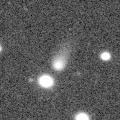
|
It is expected to brighten up to 7 mag in early 2024. Now it is 14.1 mag (June 19, Chris Wyatt). Brightening gradually. In the Northern Hemisphere, it is not observable now, but it will appear in November. It locates somewhat low in the Southern Hemisphere. But it will become high in winter. The brightness evolution slowed down since May.
Date(TT) R.A. (2000) Decl. Delta r Elong. m1 Best Time(A, h)
July 15 7 23.18 -23 49.3 3.778 3.151 45 12.9 3:13 (269,-46)
July 22 7 35.15 -24 8.9 3.710 3.078 45 12.7 3:20 (273,-41)
|
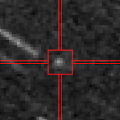
|
It is expected to brighten up to 7.5 mag in October. Now it is 16.8 mag (June 29, Taras Prystavski). Brightening rapidly. In the Northern Hemisphere, it stays observable in good condition. It locates somewhat low in the Southern Hemisphere. But it will become high in autumn. It is much fainter than this ephemeris recently. However, Thomas Lehmann reported it is bright as 14.7 mag on June 17. In the Southern Hemisphere, it becomes low temporarily around the high light.
Date(TT) R.A. (2000) Decl. Delta r Elong. m1 Best Time(A, h)
July 15 23 25.98 21 34.9 0.924 1.581 108 13.4 3:13 (322, 74)
July 22 23 42.61 24 40.9 0.834 1.520 110 12.9 3:20 (330, 78)
|

|
It brightened up to 8.3 mag in 2021-2022 winter (Jan. 6, 2022, Toshiyuki Takahashi). Now it is 13.2 mag (July 14, Chris Wyatt). It stays 13 mag for a while. In the Northern Hemisphere, it is not observable now, but it will appear in November. It locates somewhat low in the Southern Hemisphere. But it will become high in autumn.
Date(TT) R.A. (2000) Decl. Delta r Elong. m1 Best Time(A, h)
July 15 9 45.26 -30 29.6 6.367 5.938 60 13.0 20:57 ( 69,-25)
July 22 9 50.76 -30 47.3 6.468 5.982 57 13.0 20:51 ( 70,-28)
|
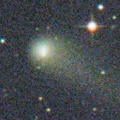
|
It brightened up to 11.1 mag in early 2022 (Mar. 31, 2022, F. Kugel, J.-G. Bosch, J. Nicolas). Now it is 13.3 mag (July 16, Toshihiko Ikemura, Hirohisa Sato). Fading slowly. In the Northern Hemisphere, it stays observable in good condition. In the Southern Hemisphere, it will be getting lower gradually after this, and it will be unobservable in October.
Date(TT) R.A. (2000) Decl. Delta r Elong. m1 Best Time(A, h)
July 15 15 12.06 21 25.4 5.037 5.355 102 13.6 20:57 ( 56, 68)
July 22 15 12.65 21 7.9 5.156 5.388 97 13.7 20:51 ( 63, 64)
|
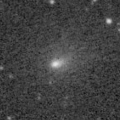
|
Now it is 13.3 mag (July 13, Thomas Lehmann). It will fade out rapidly after this. In the Northern Hemisphere, it stays observable in good condition. In the Southern Hemisphere, it is not observable now, but it will appear in August.
Date(TT) R.A. (2000) Decl. Delta r Elong. m1 Best Time(A, h)
July 15 23 27.39 65 15.9 1.152 1.434 82 13.9 3:13 (189, 59)
July 22 22 33.48 63 1.2 1.023 1.460 91 13.7 2:39 (180, 62)
|

|
Now it is 14 mag (July 15, Michael Mattiazzo). Fading slowly. In the Northern Hemisphere, it stays observable in good condition. In the Southern Hemisphere, it will be getting lower gradually after this, and it will be unobservable in September.
Date(TT) R.A. (2000) Decl. Delta r Elong. m1 Best Time(A, h)
July 15 2 7.55 14 37.6 1.622 1.714 77 13.8 3:13 (281, 40)
July 22 2 15.63 18 43.9 1.561 1.720 80 13.7 3:20 (280, 47)
|

|
It stays 14 mag for a while. Now it is not observable. It will appear in August.
Date(TT) R.A. (2000) Decl. Delta r Elong. m1 Best Time(A, h)
July 15 7 33.61 24 40.8 7.132 6.117 3 14.2 3:13 (224,-16)
July 22 7 39.35 24 24.4 7.127 6.119 6 14.2 3:20 (229,-11)
|

|
Now it is 14.9 mag (July 5, ATLAS Chile). Fading gradually. In the Southern Hemisphere, it stays observable in good condition.
Date(TT) R.A. (2000) Decl. Delta r Elong. m1 Best Time(A, h)
July 15 16 56.97 -18 57.5 1.604 2.492 142 14.2 21:25 ( 0, 36)
July 22 16 55.87 -19 11.0 1.701 2.533 136 14.4 20:57 ( 0, 36)
|

|
It approached to Earth down to 0.29 a.u. in early February, and it brightened up to 4.5 mag (Feb. 1, Juan Jose Gonzalez). Now it is 14 mag (July 15, Michael Mattiazzo). Fading slowly. In the Northern Hemisphere, it is not observable now, but it will appear in September. In the Southern Hemisphere, it will be getting higher gradually.
Date(TT) R.A. (2000) Decl. Delta r Elong. m1 Best Time(A, h)
July 15 6 15.46 -24 1.8 3.401 2.849 49 14.2 3:13 (279,-32)
July 22 6 20.30 -25 44.8 3.433 2.928 52 14.3 3:20 (284,-27)
|

|
The brightness evolution is slower than originally predicted. Now it is 14.3 mag (July 7, Thomas Lehmann). Fading slowly. In the Northern Hemisphere, it is not observable now. It locates somewhat low in the Southern Hemisphere. But it will become high in winter.
Date(TT) R.A. (2000) Decl. Delta r Elong. m1 Best Time(A, h)
July 15 8 7.00 -41 17.8 2.485 2.223 63 14.2 20:57 ( 64,-47)
July 22 8 32.48 -42 49.7 2.518 2.258 63 14.3 20:51 ( 62,-47)
|
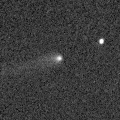
|
Now it is 14.5 mag (July 10, Ken-ichi Kadota). It stays 14 mag for a while. It stays observable in good condition.
Date(TT) R.A. (2000) Decl. Delta r Elong. m1 Best Time(A, h)
July 15 2 36.57 6 25.8 3.410 3.267 73 14.3 3:13 (283, 29)
July 22 2 32.54 6 48.7 3.283 3.277 80 14.2 3:20 (290, 37)
|

|
Now it is 14.7 mag (June 13, Jean-Claude Merlin). Fading slowly. It locates somewhat low in the Northern Hemisphere. In the Southern Hemisphere, it stays observable in good condition.
Date(TT) R.A. (2000) Decl. Delta r Elong. m1 Best Time(A, h)
July 15 18 2.17 -27 14.7 1.947 2.915 158 14.6 22:30 ( 0, 28)
July 22 17 58.23 -28 13.1 1.984 2.913 150 14.6 21:59 ( 0, 27)
|
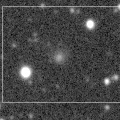
|
Now it is 14.8 mag (July 17, Toshihiko Ikemura, Hirohisa Sato). It stays 15 mag for a while. It will be getting lower gradually after this, and it will be unobservable in October. It is expected to brighten up to 12.5 mag in 2024 spring. At the high light, it will be observable in excellent condition in the Southern Hemisphere, but it will be low in the Northern Hemisphere.
Date(TT) R.A. (2000) Decl. Delta r Elong. m1 Best Time(A, h)
July 15 15 56.50 17 24.9 3.114 3.645 113 14.7 20:57 ( 25, 71)
July 22 15 46.09 15 48.7 3.165 3.600 107 14.7 20:51 ( 41, 66)
|

|
It brightened very rapidly. Now it is 14.9 mag (July 6, ATLAS Chile). Fading slowly. In the Northern Hemisphere, it is not observable now. In the Southern Hemisphere, it will be getting lower gradually after this, and it will be unobservable in October.
Date(TT) R.A. (2000) Decl. Delta r Elong. m1 Best Time(A, h)
July 15 14 15.82 -61 24.4 1.520 2.142 113 15.0 20:57 ( 16,-10)
July 22 14 1.49 -54 7.1 1.597 2.118 106 14.8 20:51 ( 24, -6)
|
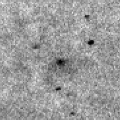
|
It brightened up to 12.8 mag in spring (Mar. 8, Taras Prystavski). Now it is 16.0 mag (July 16, Toshihiko Ikemura, Hirohisa Sato). Fading gradually. It stays observable in good condition.
Date(TT) R.A. (2000) Decl. Delta r Elong. m1 Best Time(A, h)
July 15 1 22.02 -2 28.4 1.900 2.215 93 14.8 3:13 (306, 37)
July 22 1 27.18 -2 14.7 1.855 2.253 99 14.9 3:20 (314, 42)
|
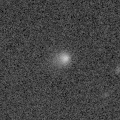
|
Now it is 15.6 mag (July 8, Thomas Lehmann). Brightening slowly. In the Northern Hemisphere, it is not observable now, but it will appear in September. In the Southern Hemisphere, it will be unobservable in August. But it will be observable again in September. It is expected to brighten up to 12 mag from 2024 to 2025.
Date(TT) R.A. (2000) Decl. Delta r Elong. m1 Best Time(A, h)
July 15 9 6.52 2 3.7 6.070 5.211 29 15.1 20:57 (104,-15)
July 22 9 9.25 2 23.0 6.081 5.171 24 15.0 20:51 (107,-19)
|

|
The ATLAS search program detected its cometary activity in April. It continues to be brightening even after the perihelion passage. Now it is 14.7 mag (July 10, Ken-ichi Kadota). Fading slowly. It locates somewhat low in the Northern Hemisphere. But it will become high in autumn. In the Southern Hemisphere, it stays observable in good condition.
Date(TT) R.A. (2000) Decl. Delta r Elong. m1 Best Time(A, h)
July 15 23 56.12 -24 46.1 2.142 2.798 120 15.1 3:13 (341, 28)
July 22 23 59.07 -25 7.5 2.101 2.819 125 15.1 3:20 (349, 29)
|
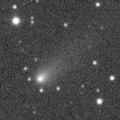
|
Now it is 15.5 mag (July 3, ATLAS South Africa). Fading gradually. In the Northern Hemisphere, it will be unobservable in August. In the Southern Hemisphere, it stays observable in good condition.
Date(TT) R.A. (2000) Decl. Delta r Elong. m1 Best Time(A, h)
July 15 13 38.48 -33 58.5 2.013 2.445 102 15.2 20:57 ( 35, 10)
July 22 13 45.70 -34 24.9 2.101 2.458 97 15.4 20:51 ( 37, 8)
|

|
It will brighten up to 14 mag from 2024 to 2025. Now it is 15.3 mag (July 4, ATLAS Chile). It stays 15 mag for a while. In the Northern Hemisphere, it is not observable now, but it will appear in October. It locates somewhat low in the Southern Hemisphere. But it will become high in autumn.
Date(TT) R.A. (2000) Decl. Delta r Elong. m1 Best Time(A, h)
July 15 9 39.19 -26 55.1 6.413 5.923 57 15.3 20:57 ( 73,-25)
July 22 9 45.62 -26 50.1 6.445 5.896 53 15.3 20:51 ( 75,-28)
|

|
Now it is 15.8 mag (July 4, ATLAS Chile). It stays 16 mag for a while. It stays observable in good condition.
Date(TT) R.A. (2000) Decl. Delta r Elong. m1 Best Time(A, h)
July 15 0 45.74 -4 50.3 3.136 3.510 103 15.3 3:13 (317, 41)
July 22 0 47.81 -4 49.9 3.056 3.525 109 15.3 3:20 (327, 45)
|

|
It has not been observed yet in this apparition. It was expected to brighten rapidly up to 15 mag in summer. But actually, it is not detected, fainter than 18.5 mag (July 18, Martin Masek). It stays 16 mag for a while. It locates somewhat low in the Northern Hemisphere. In the Southern Hemisphere, it stays observable in good condition.
Date(TT) R.A. (2000) Decl. Delta r Elong. m1 Best Time(A, h)
July 15 16 42.41 -33 49.5 1.300 2.181 140 15.9 21:11 ( 0, 21)
July 22 16 41.56 -32 52.4 1.328 2.160 133 15.7 20:51 ( 2, 22)
|
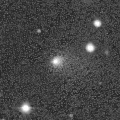
|
It returns for the first time in 70 years. It will brighten up to 4.5 mag in 2024 spring. Now it is 16.1 mag (July 13, Thomas Lehmann). Brightening gradually. In the Northern Hemisphere, it stays observable in good condition. In the Southern Hemisphere, it is not observable now, but it will appear in August.
Date(TT) R.A. (2000) Decl. Delta r Elong. m1 Best Time(A, h)
July 15 18 27.97 55 40.4 3.612 3.941 101 15.8 22:54 (180, 69)
July 22 18 16.30 55 50.1 3.554 3.869 100 15.7 22:15 (180, 69)
|

|
It will approach to Sun down to 0.4 a.u. in late September in 2024, and it is expected to brighten up to 0 mag. Now it is 16.7 mag (July 7, Thomas Lehmann). Brightening slowly. It will be getting lower gradually after this, and it will be unobservable in October. At the high light, in the Northern Hemisphere, it will be observable in good condition after the perihelion passage. In the Southern Hemisphere, it will be observable in the low sky before and after the perihelion passage.
Date(TT) R.A. (2000) Decl. Delta r Elong. m1 Best Time(A, h)
July 15 14 6.57 2 45.7 5.809 6.007 96 16.1 20:57 ( 54, 44)
July 22 14 4.88 2 29.3 5.860 5.939 89 16.1 20:51 ( 59, 40)
|

|
It brightened up to 13.4 mag in last summer (July 7, 2022, Giuseppe Pappa). Now it is 16.3 mag (July 17, Toshihiko Ikemura, Hirohisa Sato). Fading slowly. In the Northern Hemisphere, it stays observable in good condition. In the Southern Hemisphere, it will be unobservable in September.
Date(TT) R.A. (2000) Decl. Delta r Elong. m1 Best Time(A, h)
July 15 15 38.19 33 57.9 3.839 4.153 100 16.3 20:57 ( 88, 79)
July 22 15 32.25 33 40.5 3.971 4.198 95 16.4 20:51 ( 91, 74)
|
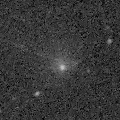
|
Very large comet. It is expected to brighten up to 13 mag in 2031. Now it is 15.9 mag (June 25, Thomas Lehmann). It stays 16 mag for a while. In the Northern Hemisphere, it is not observable now. In the Southern Hemisphere, it stays observable in good condition. In the Northern Hemisphere, it is not observable until 2030.
Date(TT) R.A. (2000) Decl. Delta r Elong. m1 Best Time(A, h)
July 15 3 25.84 -59 28.0 17.322 17.451 95 16.4 3:13 (329,-21)
July 22 3 27.91 -59 52.1 17.263 17.426 97 16.4 3:20 (332,-18)
|
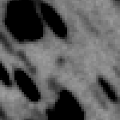
|
Now it is 17.4 mag (July 5, ATLAS South Africa). It stays 17 mag for a while. It stays observable in good condition.
Date(TT) R.A. (2000) Decl. Delta r Elong. m1 Best Time(A, h)
July 15 17 51.53 -10 37.5 1.780 2.725 152 16.6 22:19 ( 0, 44)
July 22 17 47.49 -10 30.5 1.802 2.704 145 16.6 21:48 ( 0, 44)
|

|
Very far object. Now it is 17.0 mag (May 11, ATLAS South Africa). It stays 17 mag for a while. In the Northern Hemisphere, it is not observable now. In the Southern Hemisphere, it stays observable in good condition.
Date(TT) R.A. (2000) Decl. Delta r Elong. m1 Best Time(A, h)
July 15 5 38.28 -68 0.1 10.245 10.334 92 16.8 3:13 (333,-37)
July 22 5 41.30 -68 22.4 10.238 10.332 92 16.8 3:20 (334,-34)
|

|
It brightened up to 14.1 mag in 2022 spring (Mar. 22, 2022, Chris Wyatt). It was expected to brighten up to 13 mag. But actually, it was fainter than originally expected. Now it is 16.2 mag (July 17, Toshihiko Ikemura, Hirohisa Sato). It stays 17 mag for a while. In the Northern Hemisphere, it will be getting higher gradually. In the Southern Hemisphere, it stays observable in good condition.
Date(TT) R.A. (2000) Decl. Delta r Elong. m1 Best Time(A, h)
July 15 3 6.65 -3 23.3 5.049 4.800 70 16.9 3:13 (287, 17)
July 22 3 6.79 -3 8.0 4.986 4.846 76 16.9 3:20 (293, 24)
|

|
It will brighten up to 7.5 mag in October. Now it is 17.9 mag (June 25, A. Hale). Brightening rapidly. It will be unobservable in September in the Southern Hemisphere, or in October in the Northern Hemisphere. But it will be observable again in July in the Northern Hemisphere.
Date(TT) R.A. (2000) Decl. Delta r Elong. m1 Best Time(A, h)
July 15 3 4.53 24 55.7 2.041 1.794 61 17.7 3:13 (261, 33)
July 22 3 22.01 26 27.2 1.892 1.710 63 17.0 3:20 (261, 37)
|

|
It is expected to brighten up to 14 mag in winter. Now it is 19.8 mag (June 30, Masayuki Suzuki). Brightening gradually. It stays observable in good condition. It is fainter than this ephemeris recently.
Date(TT) R.A. (2000) Decl. Delta r Elong. m1 Best Time(A, h)
July 15 2 38.10 10 3.4 3.242 3.078 71 17.4 3:13 (280, 31)
July 22 2 45.69 10 41.8 3.115 3.040 76 17.3 3:20 (284, 37)
|
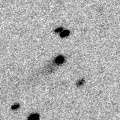
|
Now it is 17.4 mag (July 17, Toshihiko Ikemura, Hirohisa Sato). It stays 17 mag for a while. It will be unobservable in August in the Southern Hemisphere, or in September in the Northern Hemisphere. But it will be observable again in October in the Northern Hemisphere.
Date(TT) R.A. (2000) Decl. Delta r Elong. m1 Best Time(A, h)
July 15 12 14.98 14 14.9 9.424 9.067 66 17.3 20:57 ( 87, 30)
July 22 12 14.79 14 7.8 9.540 9.076 60 17.3 20:51 ( 90, 25)
|
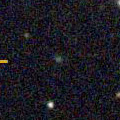
|
Now it is 17.4 mag (Feb. 16, Toshihiko Ikemura, Hirohisa Sato). It stays 17 mag for a while. In the Northern Hemisphere, it will be getting higher gradually. It stays extremely low in the Southern Hemisphere.
Date(TT) R.A. (2000) Decl. Delta r Elong. m1 Best Time(A, h)
July 15 4 21.98 35 16.5 7.476 6.782 44 17.4 3:13 (242, 23)
July 22 4 27.31 35 40.7 7.393 6.775 49 17.3 3:20 (244, 28)
|

|
First return of a new periodic comet which brightened up to 15 mag in 2008. Now it is 18.2 mag (June 16, Toshihiko Ikemura, Hirohisa Sato). It stays 18 mag for a while. In the Northern Hemisphere, it stays observable in good condition.
Date(TT) R.A. (2000) Decl. Delta r Elong. m1 Best Time(A, h)
July 15 2 48.04 22 45.3 2.634 2.401 65 17.4 3:13 (265, 36)
July 22 2 59.71 22 48.6 2.573 2.417 69 17.4 3:20 (268, 40)
|

|
It is expected to brighten up to 14 mag in 2024 summer. At the high light, it is not observable in the Northern Hemisphere. Now it is 18.6 mag (Feb. 16, Toshihiko Ikemura, Hirohisa Sato). Brightening slowly. In the Northern Hemisphere, it will be getting higher gradually. In the Southern Hemisphere, it stays observable in good condition.
Date(TT) R.A. (2000) Decl. Delta r Elong. m1 Best Time(A, h)
July 15 3 19.51 8 11.8 4.927 4.551 62 17.5 3:13 (275, 22)
July 22 3 22.79 7 26.0 4.769 4.502 68 17.4 3:20 (281, 28)
|

|
Now it is 17.6 mag (July 17, Toshihiko Ikemura, Hirohisa Sato). It stays 18 mag for a while. In the Northern Hemisphere, it stays observable in good condition. It stays extremely low in the Southern Hemisphere.
Date(TT) R.A. (2000) Decl. Delta r Elong. m1 Best Time(A, h)
July 15 13 43.77 44 26.3 2.968 2.905 76 17.5 20:57 (119, 57)
July 22 13 52.88 42 35.9 3.002 2.901 74 17.5 20:51 (116, 55)
|

|
It brightened up to 13.6 mag in 2021 (June 17, 2021, R. Carstens). Now it is 17.3 mag (June 9, D. Husar, M. Junius, S. Messner). It stays 18 mag for a while. In the Northern Hemisphere, it will never be observable after this. In the Southern Hemisphere, it will be getting lower gradually.
Date(TT) R.A. (2000) Decl. Delta r Elong. m1 Best Time(A, h)
July 15 11 0.44 -62 14.4 6.671 6.805 93 17.5 20:57 ( 31,-27)
July 22 11 1.96 -61 36.1 6.772 6.838 89 17.5 20:51 ( 33,-29)
|

|
Now it is 17.8 mag (Feb. 26, Jean-Claude Merlin). It stays 17 mag for a while. In the Northern Hemisphere, it will be getting higher gradually. In the Southern Hemisphere, it stays observable in good condition.
Date(TT) R.A. (2000) Decl. Delta r Elong. m1 Best Time(A, h)
July 15 4 34.76 -8 53.3 8.391 7.832 53 17.6 3:13 (278, -4)
July 22 4 38.39 -8 55.5 8.286 7.799 58 17.5 3:20 (283, 3)
|

|
It will brighten up to 16 mag in next winter. Now it is 17.9 mag (June 16, Toshihiko Ikemura, Hirohisa Sato). It stays 17 mag for a while. In the Northern Hemisphere, it will be getting lower gradually after this, and it will be unobservable in September. But it will be observable again in September. In the Southern Hemisphere, it is not observable now, but it will appear in November.
Date(TT) R.A. (2000) Decl. Delta r Elong. m1 Best Time(A, h)
July 15 11 11.03 53 18.1 2.915 2.418 51 17.7 20:57 (135, 33)
July 22 11 12.03 49 52.0 2.945 2.378 47 17.6 20:51 (132, 29)
|

|
It brightened up to 12.7 mag in last year (Feb. 27, 2022, Jose Guilherme de S. Aguiar). Now it is 17.5 mag (June 16, Toshihiko Ikemura, Hirohisa Sato). Fading gradually. It will be fainter than 18 mag in August. It locates somewhat low in the Northern Hemisphere. In the Southern Hemisphere, it stays observable in good condition.
Date(TT) R.A. (2000) Decl. Delta r Elong. m1 Best Time(A, h)
July 15 19 37.67 -26 55.3 2.151 3.165 174 17.7 0:10 ( 0, 28)
July 22 19 31.58 -27 6.0 2.184 3.190 170 17.8 23:32 ( 0, 28)
|

|
It showed cometary activity in 2023, and brightened rapidly. Now it is 17.4 mag (June 22, ATLAS South Africa). Fading slowly. It will be fainter than 18 mag in August. It stays extremely low in the Northern Hemisphere. In the Southern Hemisphere, it stays observable in good condition.
Date(TT) R.A. (2000) Decl. Delta r Elong. m1 Best Time(A, h)
July 15 14 21.76 -39 18.8 2.922 3.439 112 17.8 20:57 ( 24, 10)
July 22 14 26.06 -38 39.9 3.010 3.446 106 17.8 20:51 ( 28, 9)
|

|
It approached to Earth down to 0.12 a.u. in April, and brightened up to 11.5 mag (Apr. 8, Osamu Miyazaki). Now it is 15 mag (July 15, Michael Mattiazzo). Fading slowly. It stays observable in good condition.
Date(TT) R.A. (2000) Decl. Delta r Elong. m1 Best Time(A, h)
July 15 2 27.86 -0 48.5 0.952 1.240 78 17.8 3:13 (292, 27)
July 22 2 33.97 -0 16.0 0.968 1.313 82 18.4 3:20 (296, 32)
|

|
It returns for the first time in 68 years. It will brighten up to 7.5 mag in 2024 summer. It has not been observed yet in this apparition. It will brighten rapidly after this. In the Northern Hemisphere, it will be getting higher gradually. In the Southern Hemisphere, it stays observable in good condition. At the high light, it locates low in the Northern Hemisphere, or it is not observable in the Southern Hemisphere.
Date(TT) R.A. (2000) Decl. Delta r Elong. m1 Best Time(A, h)
July 15 3 54.05 -13 39.7 4.723 4.385 64 18.0 3:13 (288, 2)
July 22 3 59.37 -13 42.2 4.581 4.321 68 17.8 3:20 (292, 7)
|
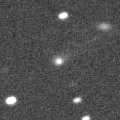
|
It brightened up to 15.9 mag in 2022 spring (May 5, Toshiyuki Takahashi). Now it is 17.4 mag (June 25, N. Paul, E. Cortes). It stays 18 mag for a while. It locates somewhat low in the Northern Hemisphere. In the Southern Hemisphere, it stays observable in good condition.
Date(TT) R.A. (2000) Decl. Delta r Elong. m1 Best Time(A, h)
July 15 15 51.95 -23 38.2 4.303 5.003 128 17.9 20:57 ( 10, 31)
July 22 15 51.40 -23 35.0 4.398 5.012 122 17.9 20:51 ( 15, 30)
|

|
Now it is 17.4 mag (June 29, ATLAS-HKO, Haleakala). It stays 18 mag for a while. In the Northern Hemisphere, it stays observable in good condition. In the Southern Hemisphere, it will never be observable after this.
Date(TT) R.A. (2000) Decl. Delta r Elong. m1 Best Time(A, h)
July 15 15 2.96 78 53.8 10.352 10.099 72 17.9 20:57 (174, 45)
July 22 14 53.12 78 21.3 10.378 10.119 72 17.9 20:51 (172, 45)
|

|
It stays 18 mag for a while. In the Northern Hemisphere, it will be getting higher gradually. In the Southern Hemisphere, it stays observable in good condition.
Date(TT) R.A. (2000) Decl. Delta r Elong. m1 Best Time(A, h)
July 15 3 2.83 8 29.3 3.217 2.963 66 17.9 3:13 (277, 25)
July 22 3 11.34 8 44.6 3.139 2.969 71 17.9 3:20 (281, 31)
|

|
It was predicted to brighten up to 16 mag in 2023. But actually, it is very faint as 18.8 mag (June 26, Jean-Claude Merlin). Fading slowly. In the Northern Hemisphere, it is not observable now. In the Southern Hemisphere, it stays observable in good condition.
Date(TT) R.A. (2000) Decl. Delta r Elong. m1 Best Time(A, h)
July 15 19 1.20 -74 55.5 2.854 3.555 126 18.4 23:30 ( 0,-20)
July 22 18 47.32 -73 28.2 2.890 3.582 125 18.5 22:49 ( 0,-18)
|
|
![]()
 71P/Clark
71P/Clark C/2022 E2 ( ATLAS )
C/2022 E2 ( ATLAS ) C/2022 JK5 ( PanSTARRS )
C/2022 JK5 ( PanSTARRS ) 77P/Longmore
77P/Longmore C/2021 G2 ( ATLAS )
C/2021 G2 ( ATLAS ) 117P/Helin-Roman-Alu 1
117P/Helin-Roman-Alu 1 213P/Van Ness
213P/Van Ness 12P/Pons-Brooks
12P/Pons-Brooks C/2023 A3 ( Tsuchinshan-ATLAS )
C/2023 A3 ( Tsuchinshan-ATLAS ) C/2020 R7 ( ATLAS )
C/2020 R7 ( ATLAS ) C/2014 UN271 ( Bernardinelli-Bernstein )
C/2014 UN271 ( Bernardinelli-Bernstein ) 219P/LINEAR
219P/LINEAR C/2019 E3 ( ATLAS )
C/2019 E3 ( ATLAS ) C/2020 Y2 ( ATLAS )
C/2020 Y2 ( ATLAS ) 2P/Encke
2P/Encke 32P/Comas Sola
32P/Comas Sola C/2020 F2 ( ATLAS )
C/2020 F2 ( ATLAS ) C/2021 S4 ( Tsuchinshan )
C/2021 S4 ( Tsuchinshan ) P/2023 L1 ( Hill )
P/2023 L1 ( Hill ) C/2022 S4 ( Lemmon )
C/2022 S4 ( Lemmon ) C/2022 U4 ( Bok )
C/2022 U4 ( Bok ) C/2018 U1 ( Lemmon )
C/2018 U1 ( Lemmon ) C/2022 QE78 ( ATLAS )
C/2022 QE78 ( ATLAS ) C/2022 V2 ( Lemmon )
C/2022 V2 ( Lemmon ) 116P/Wild 4
116P/Wild 4 P/2014 OL465 ( PanSTARRS )
P/2014 OL465 ( PanSTARRS ) 364P/PanSTARRS
364P/PanSTARRS 13P/Olbers
13P/Olbers 99P/Kowal 1
99P/Kowal 1 C/2019 O3 ( Palomar )
C/2019 O3 ( Palomar ) 170P/Christensen
170P/Christensen C/2021 C5 ( PanSTARRS )
C/2021 C5 ( PanSTARRS )![]()















































